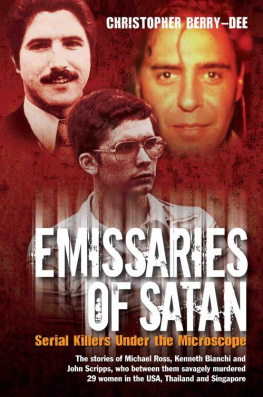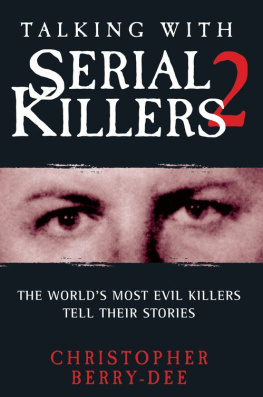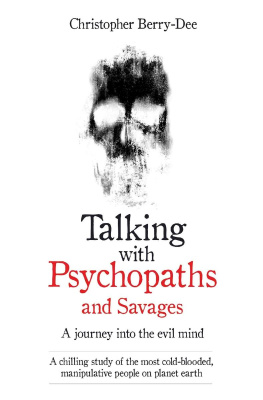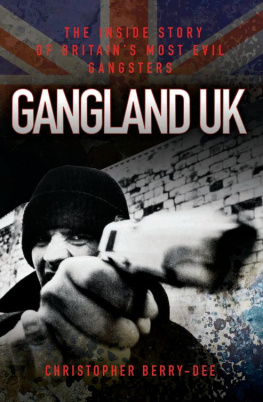I started corresponding with the three serial killers featured in this book as far back as the early 1990s, and subsequently worked with them for many years. Given that, by their very nature, they are, or were, all psychopaths and born-again pathological liars, the reader may not be surprised to discover that various other accounts of their lives and crimes may be found in other publications and on the Worldwide Web. What an offender says one day he may well change to something else the next day, ad infinitum, as the police, their legal advisers and the judiciary will confirm.
Michael Bruce Ross, Kenneth Alessio Bianchi and John Martin Scripps have formed chapters in two of my previous books: my international bestseller Talking With Serial Killers and its sequel, Talking With Serial Killers 2. I also made TV documentaries with the cooperation of Ross and Bianchi these DVDs are available online.
Time and tide wait for no man, so a popular saying goes, and this applies to the study of the criminal mind. And, since those early 90s, and the publication of the two aforementioned books, Ross and Scripps have been executed, while Bianchi still rots in prison. However, the passing of time can be a good thing, for it allows a cooling of tempers and perhaps a more measured view of the enormity of their sickening murders. With this in mind, therefore, my publishers and I felt that now is the right time to revisit these three men; to re-evaluate their heinous behaviour; to consider much else that has been written about them; and to combine everything into this reassessment, which I have called Emissaries of Satan.
Not surprisingly, other accounts concerning these three serial killers have appeared since my two original volumes were first published, and I have striven in this book to acknowledge this where possible, albeit with a caveat: I cannot always verify the accuracy of that information, simply because much of the source of this material is unknown to me, to the degree that it was not until my copy-editor brought various issues to my attention that I was aware that it even existed.
I have rectified this omission as best as I can, to leave you with this: to verify any accounts of their lives and crimes given to me first-hand by Ross, Bianchi and Scripps, I visited every one of their crime scenes in the US, Thailand and Singapore. I spoke to most of the law-enforcement officers concerned, prosecution and defence attorneys, judges, scenes-of-crime technicians, correctional staff, the offenders families, likewise, where possible the victims tragic nearest and dearest. Added to which were the thousands of official documents and photographs supplied to me concerning each case, in order to separate the truth from hearsay and fiction.
My two Talking With Serial Killers books are among required reading for students at the FBIs Behavioral Science Unit, Quantico, VA, so I truly hope the reader will find Emissaries of Satan a valuable and worthwhile upgrade, too.
CHRISTOPHER BERRY-DEE
A s bizarre as this may seem, special thanks have to go to the three serial murderers who make up this book for without their cooperation Emissaries of Satan could not have been written: Michael Bruce Ross has since been executed, by lethal injection, in Connecticut; Kenneth Alessio Bianchi now sits in a special housing unit at the Washington State Penitentiary, while John Martin Scripps was hanged in Singapore.
In part, much credit is due to my long-time TV documentary producer, Frazer Ashford, who made it possible for me to finance my interviews with Ross and Bianchi. Also to the Mail on Sunday, who commissioned me to investigate the killings committed by John Scripps, and to APTV who screened my exclusive report on Scrippss hanging for worldwide news release.
For my work with Michael Ross: thanks go to the Connecticut State Police Detective Michael Malchik; the New York State Police; Crystal Run PD; the Connecticut Department of Corrections, Warden J. Kupec; the officers at the Osborn Correction Institution, who made my visits to interview Ross on death row secure; and to New London County States Attorney, the late C. Robert Bulldog Satti.
For my work with Kenneth Bianchi: much appreciation to the Los Angeles PD, specifically Detectives Leroy Orozco and Richard Crotsley; to Judge Roger Boren; to the Bellingham PD with Chief Terry Mangan, Investigator Robert Knudsen, Detectives Terry Wight and Fred Nolte; to Chase Riveland, Director of Washington Department of Corrections and the officers at WSP; and finally Frances Piccione (formerly Bianchi).
For my work with John Scripps, thanks to the family of John Martin Scripps; HM Customs & Excise (Special Investigations); the Singapore Police; Royal Thai Police; Royal Canadian Mounted Police; the Singapore Supreme Court; Changi Prison; the staff at the River View Hotel, Singapore; the staff at Nillys Marina Inn, Phuket; the Singapore Straits Times, the Mail on Sunday, the BBC and APTV.
Where other credits are due they can be found throughout the text, while other extracts are drawn from Talking With Serial Killers and Talking With Serial Killers 2, published by John Blake, London, in 2003 and 2005 respectively.
F or some individuals along the road of life theres a place called Murder Crossroads. This is where two lives meet: one comes to a terrifying end, and the other takes a permanent detour, perhaps to end up on death row. And the statistics are chilling. At any one time, there are over 3,700 men and women awaiting execution in super-max facilities across the US and, on average, they will have killed three times their number.
To qualify for a cell on the row, the crime committed has to be one of aggravated first-degree murder. The law in the US requires that the aggravating circumstances have to be proved, whether rape or burglary, or simply trying to avoid being given a speeding ticket by a cop when a murder plays a part. The killing of a police, fire or correctional officer qualifies for aggravated first-degree homicide, as does, in certain circumstances, causing a victim to suffer agonising physical pain and tortuous mental anguish before death supervenes.
The case of James Leroy Brett, who once lived on death row at the Washington State Penitentiary at Walla Walla, and whom I interviewed several years ago, serves as an example. Brett explained that he had been convicted of the shooting to death of a businessman, Kenneth Milosevich. The aggravating circumstances were that the murder was committed: (1) to conceal his own identity; (2) in the furtherance of robbery in the first degree; and (3) in the course of, in furtherance of, or in the immediate flight from the burglary in the first degree and kidnapping in the first degree. Brett was convicted on 11 June 1992, and was sentenced to death seven days later. Upon appeal, his sentence was commuted to life.











